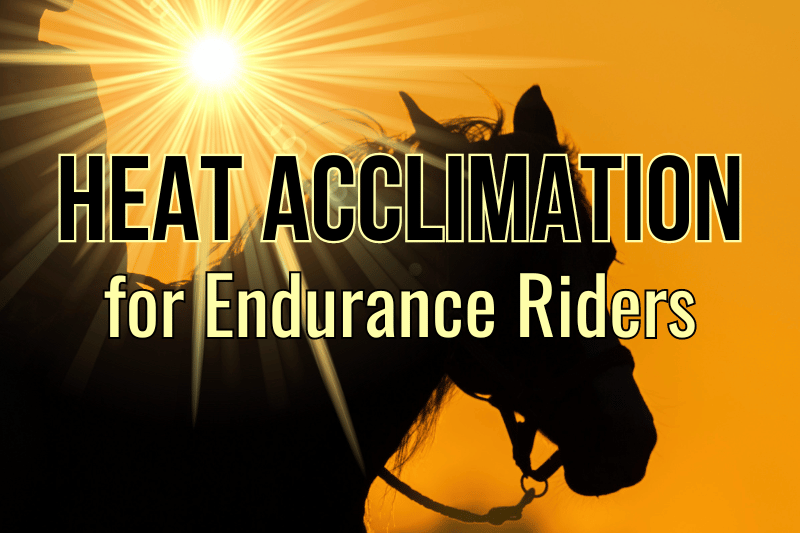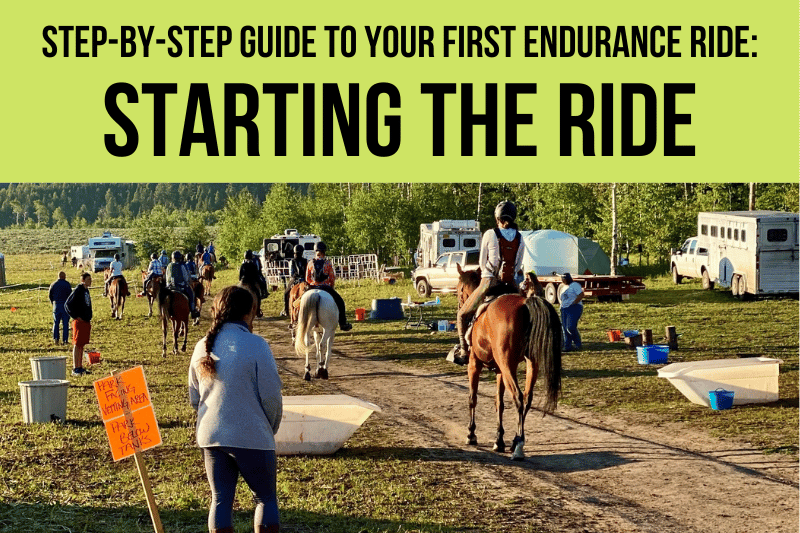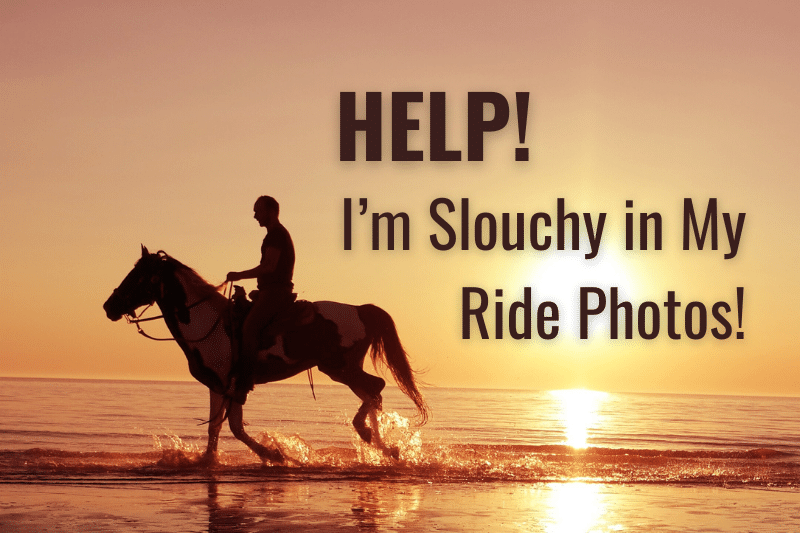It’s midday at a summer endurance ride, and your hold time is nearly up. Your horse looks great…but your own mojo has melted under the beating sun.
You’re not just saddle-weary. You are wrung out. You feel fatigued, lightheaded, and nauseated. You’re not even sure you can follow the trail markers, let alone support your horse.
Who knew the heat would punch you this hard? Now, it may cost you your ride.
Could you have done something to prevent this?
Very likely!
Heat acclimation is a tool used by all kinds of athletes (not to mention military personnel and people with physical, outdoor jobs) to improve their ability to perform in hot and/or humid conditions. Endurance riders can benefit from it as well.
Heat is top of mind for me right now, as the Tevis countdown drops below six weeks. According to teviscup.org, temperatures along the trail can get up to 120 degrees F (50 C). So, let’s explore how heat acclimation can bolster our chances of success not just at Western States, but on any sweltering endurance ride.
What is Heat Acclimation?
Heat acclimation is intentional exposure of the body to hot conditions for the purpose of inducing physiological and psychological adaptations to increase heat tolerance.
By increasing the body’s core temperature in a controlled and intentional way, repeatedly over days or weeks, it is possible to:
- Increase sweating efficiency; that is, sweat more and earlier (which sounds like a bad thing for hydration, but stay with me)
- Increase water storage in the body
- Decrease sodium concentration in sweat
- Recalibrate the thirst mechanism to better match hydration needs
- Adapt at the cellular level via heat shock protein response
- Improve VO2 max, which is the ability to use oxygen during exercise
- Increase red blood cells, mimicking altitude training for increased oxygen delivery
- Lower resting heart rate
- Increase cardiac output, which is the volume of blood pumped by the heart in a minute
- Improve glycogen sparing in the muscles, which amounts to using more bodyfat (which is a practically endless energy source even in lean individuals) and less carbohydrate for fuel
The upshot is that heat acclimation enables us to ride longer and better in hot conditions, with reduced risk of dehydration and heat stress.
Sweat More, Dehydrate Less
As Robb Wolf (the biochemist behind my favorite electrolyte product, LMNT) explains in this article, heat acclimation both increases sweat production and reduces risk of dehydration. Yes, at the same time. How is that possible?
Fellow Sweaty Equestrians, let’s review the basics:
The evaporative cooling offered by sweat is crucial for maintaining a safe core body temperature in hot conditions. However, it comes with a physiological price tag.
Sweat is drawn from the moisture in our blood plasma. This fluid loss gradually reduces the volume of our blood and increases its viscosity, forcing our hearts to work harder to supply our muscles with oxygen. Athletes in hot conditions can lose up to 10 liters of water per day (4)!
As we sweat, we also lose electrolytes including potassium, magnesium, calcium and (primarily) sodium. The sodium content of sweat varies by individual, but can range from 200 to 2,000 mg per liter (5). Athletes in this study lost 3,500 – 7,000 mg of sodium during a single day of exercise in the heat! (The FDA’s recommended daily sodium intake is 1,500 mg. I don’t necessarily agree with that recommendation, but I offer it here for perspective.)
When sodium concentrations in the blood drop too far, the result can be a condition called hyponatremia. Symptoms range from headaches, fatigue, and vomiting all the way to seizures, coma, and death. This is why drinking plain water – thereby further diluting our bodies’ dwindling sodium – is a poor strategy for endurance exercise, especially in the heat.
In an upcoming post, we’ll talk more about electrolytes, including super-hydrators like LMNT, which offers a whopping 1,000 mg of sodium per serving – perfect for pouring sweat as you acclimate for a steamy endurance ride. If you need some now, use my link to get a free sample pack with your first order – even if it’s just another sample pack!
Heat acclimation doesn’t prevent us from losing fluid through sweat. In fact, it actually increases the amount we sweat. The extent of this increase is variable among individuals, ranging from 0-20%. Since sweating means losing both fluid and sodium, shouldn’t this be a bad thing?
Well, it turns out that heat acclimation also does a few things that counteract the increased fluid loss through sweat.
For starters, heat acclimation lowers the sodium concentration in our sweat by 34-50% (6, 7, 8). This means that even though we’re sweating more, we’re not losing sodium at our pre-acclimation rate.
Heat acclimation increases blood plasma volume, giving us a larger reservoir from which to draw during exercise (9). It also recalibrates our thirst mechanisms to better reflect our hydration needs (10).
Cool, right?
Interestingly, the observable physiological effects of heat training are inadequate to fully explain its performance benefits. This has led to speculation that part of the benefit is psychological.
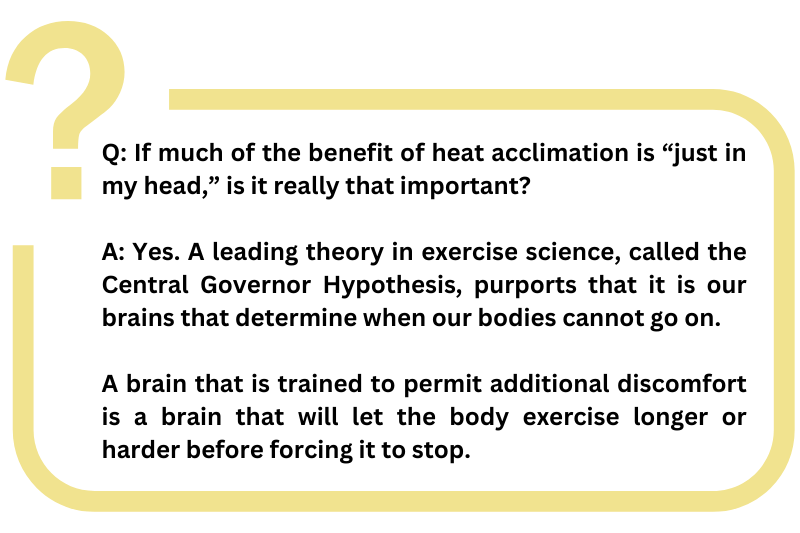
Read more about developing mental toughness for endurance riding in Happy Brain, Happy Gut, Happy Rider.
Heat Acclimation Strategies for Endurance Riders
Although some fo the reasons are not thoroughly understood, the research is clear that heat acclimation does enable athletes to perform better in hot conditions. So, how do we do it?
The critical ingredients are heat and time. We need to get our core temperatures above 101 degrees F (38.5 C) and be dripping with sweat for at least a half hour per day for about two weeks (11).
For perspective, the Mayo Clinic cites 104 degrees F (40 C) as the core temperature at which an individual should seek immediate cooling and medical help.
How Should We Get That Hot?
Obviously, we need to find ourselves some hot environments. These could be saunas, steam rooms, bathtubs, or the great outdoors. In dry heat, we’ll need higher temperatures than would be necessary if humidity is also present. In a perfect world, we’ll choose adaptation conditions that are similar to the ones in which we plan to compete.
Interestingly, heat adaptation can be accomplished either actively or passively. That is, we can adapt by either doing workouts in the heat or by simply sitting around in very hot conditions. It’s also possible to combine the two, such as by sitting in a sauna immediately after exercise.
Research suggests that incorporating heat acclimation into the actual activity for which we’re training will produce the best results (12). This is pure conjecture on my part, but it seems to me that the psychological benefits of heat acclimation would be better accessed by working in the heat than by merely sitting in a puddle of sweat.
How Long, How Often, and When?
Exact protocols vary, but most research points toward 10-14 days being the period of time needed to reap most of the physical benefits of heat acclimation (14). Women may require a longer adaptation period than men (15). Both genders can benefit from additional adaptation occurs that, albeit more slowly, with continued exposure. For example, red blood cell increase takes 3-6 weeks to see effect.
Interestingly, high levels of aerobic fitness appear to support both faster adaptation and longer retention (13). That’s one more reason to keep running as part of Getting the Rider Fit for Tevis!
During the initial acclimation period, daily heat exposure is important. Recommendations range from 30 to 120 minutes per day, sometimes broken into shorter sessions scattered throughout the day. Obviously, this wide range leaves a lot open to individual experimentation – but the upshot is that we want regular, consistent exposure every day for at least two weeks.
Once gained, the physical benefits of heat acclimation are not permanent. They decline at a rate of about 2.5% per day starting about a week after acclimation activity stops (13). However, the benefits can be maintained with less frequent exposure, such as one session every three days.
Heat acclimation is a stressor, so it’s best not to pack our heat acclimation into the last couple weeks before a goal ride. Instead, we should implement an initial, two-week block of daily exposure starting 4-6 weeks ahead of the ride, then maintain our adaptations with heat exposure every few days.
If we end up taking breaks longer than a few days, there’s no need to panic. Re-acclimation occurs more quickly than the initial adaptation, and we can expect to regain benefits with just a handful of daily sessions.
How Should We Recover from Heat Acclimation Sessions?
Heat acclimation – even if achieved using passive methods, like sauna – is challenging for our bodies. To ensure adequate recovery, we should:
- Avoid combining heat exposure with tough workouts. Instead, workouts performed in hot conditions should be light to moderate intensity – like riding!
- Support our bodies with plenty of water, electrolytes, nutrition, and sleep.
- Consider using a device to monitor heart rate variability (HRV), which serves as an early indicator of excessive stress.
- Make sure we’re familiar with the symptoms of heat illness and consider having a buddy around to keep an eye on us during intense heat exposure.
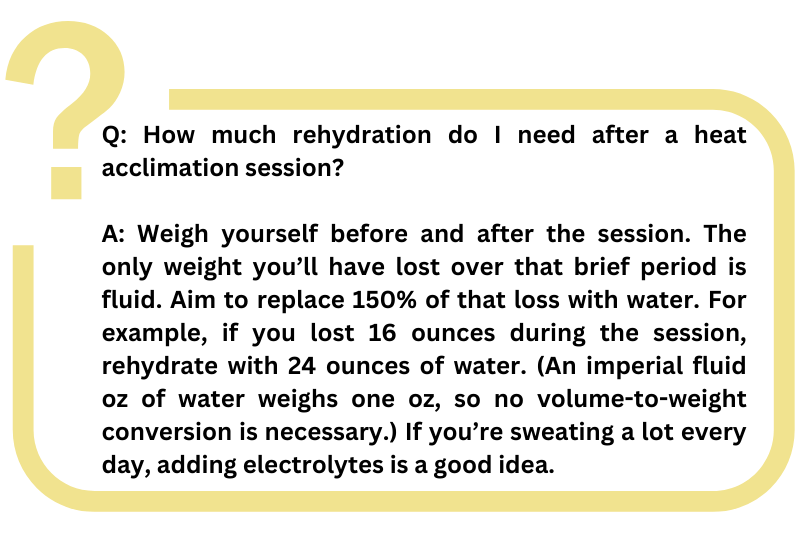
Drinking fluids during heat acclimation sessions is a good idea. However, don’t indulge in ice water or slushies. Remember that we’re trying to raise our core body temperature, so taking in cold fluid is counterproductive.
Ride day, of course, is a different story. Cooling yourself with icy beverages both before and during the event will help support your performance when it counts.
My Tevis Heat Acclimation Plan
Here’s how I’m implementing heat acclimation training for Tevis, starting this week:
I don’t have a lot of time for sitting around in a sauna or bathtub. That means I need to look for active heat acclimation opportunities. While I’m at it, I might as well get the optimal benefits of incorporating my heat training into my goal activity: endurance riding.
Conditioning rides, complete with uphill tailing and downhill running, are ideal. Both Atlas and I will benefit from (if not exactly enjoy) some sweaty afternoon rides in the high desert summer.
Since I don’t ride every day, but I do need daily heat exposure during the initial acclimation period, I’ll also be doing farm chores and horse training on 90+ degree afternoons.
I’ll also augment my daily heat exposure by using my sun-heated car as a sauna. (Oh yes, I am that crazy.) Last weekend, I got in my car after a couple hours of hiking in the heat while Atlas and I practiced tailing. I turned off the AC and let myself pour sweat 20 minutes.
If you’re going to try the car sauna, consider grabbing a thermometer. Dr. Stacy Sims notes in her book ROAR that sauna temperatures in excess of 165 degrees F (74 C) can be dangerous, and 25-30 minutes is plenty. If you’re new to heat training, start with lower temperatures and work up. Obviously, don’t actually drive if you feel lightheaded.
Because I want maximum benefits — including those increased red blood cells, which will also help with riding at high altitude — I’ll continue heat training regularly beyond the two-week acclimation period.
To support this stress on top of running, strength training, riding, and farm work, I’ll consume at least one LMNT packet daily, plus plenty of water. I’ll also get lots of sleep and eat anti-inflammatory food similar to what Atlas’ owner, Layne, is eating to support her ongoing recovery.
Overall, my plan is to keep it simple! No spreadsheets or timers – just a commitment to doing the hard thing by saving at least an hour’s worth of outdoor activity for the heat of the day.
In the final countdown to Western States, I’ll discontinue intentional heat acclimation. Once we’re en route to Lake Tahoe, my focus will shift to ensuring that both Atlas and I are maximally recovered and hydrated before we hit the canyons under that infamous Tevis sun.
You Might Also Like
This post includes affiliate links, and I may earn a small commission (at no extra cost to you) when you purchase through these links. I only recommend products and services I think are helpful and useful. Thanks for helping me offset the cost of maintaining this blog as a free resource!

